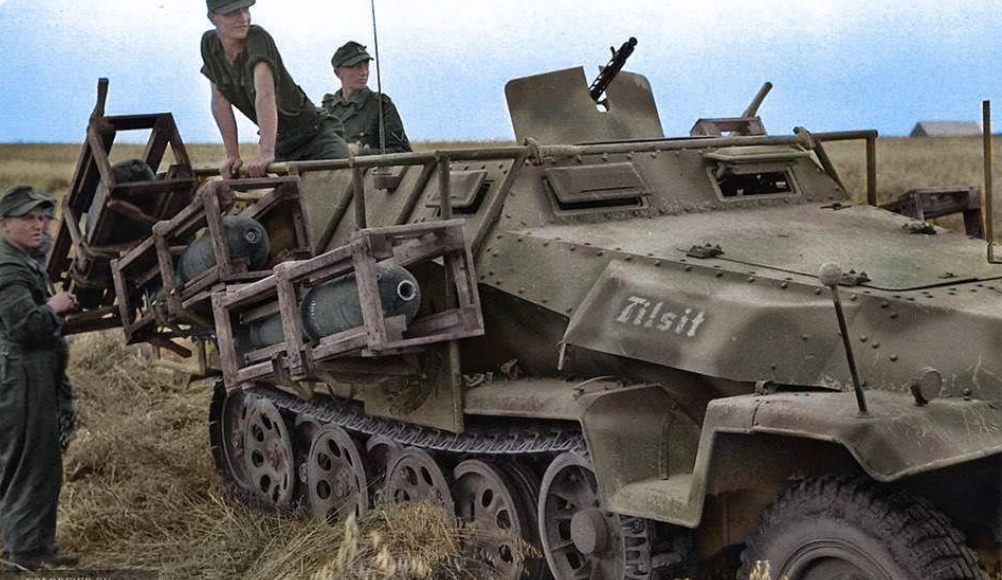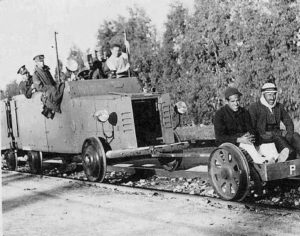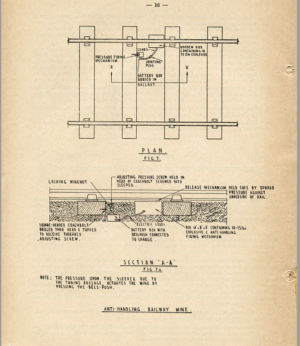If this story is true, (and it may not be), it changes what we have thought about the origins of thermobaric weapons. It also could have changed the course of WW2 in one instant. Bear with me as I explain.
Thermobaric explosive weapons came to the general attention of the defence community in the 1990s. They are still widely misunderstood. The explanation is also not helped by slightly odd nomenclature and descriptions. “Thermobaric” is one such descriptor. Sometimes “Fuel Air Explosives (FAE)” is used, sometimes “Vacuum bombs” even if the words have somewhat different meanings. Sometimes thermobaric weapons are infantry weapons, engineer demolition weapons and at other times artillery weapons. Sometimes they are deployed by Chemical units. All these lead to confusion, as do amateurs who also comment that where terrorists add gas cylinders to IEDs they are creating thermobaric or fuel air explosives, when generally that is not the case. If you need to, you should read up elsewhere on thermobarics but please go beyond the rather simplified wikipedia efforts.
Here’s a very simple summary. The ability of a fuel when mixed with air and initiated in the right mixture can cause explosions. This is well known and accidental things such as coal dust explosions in mines, and even dust in agricultural or industrial situations has been known to cause significant destruction. It is possible to artificially, rather than accidentally, cause such explosions to occur, although it is not necessarily easy. Chucking gas cylinders on top of an IED pretty much doesn’t work whatever people may tell you. The oxidisation of the fuel in the explosion and the progress of a blast wave through the fuel and air is very complex and affected by a large number of variables. What is important is the effect of such an explosion. Traditionally military weapons, at least in the West, have concentrated on attempting to reach as high a peak pressure for the blast wave as possible, on the assumption that the higher the peak pressure the higher the damage to the target. Thermobaric weapons however don’t follow that logic. On a graph of pressure over time, the energy imparted by the explosion is represented by “the area under the curve”. Thermobaric explosions give a lower peak pressure but the duration of the pressure is much longer, so there is much more energy involved. The long pressure pulse also has horribly strange effects in terms reflection, reinforcement and effects on targets, structures, and the human body. Long pulses knock buildings over very effectively so thermobaric weapons were seen as useful against structures and some of the “peculiar effects” that themobarics have in some environments made them “good” at killing people and even against armoured vehicles. That’s about all I’m going to say on that aspect of subject for now, do your own research. But they make dramatically different weapons with “new” destructive capabilities and should not be underestimated.
Some sweeping statements now, which I’m then going to hit with relatively new information:
Thermobaric weapons first came to my attention in the 1990s, like most people, I think. The story was the Russia had invested in some new technology and weapons like the shoulder launched RPO-A were the first example. Translation often (in those days and still today) classed these as “flame weapons” which confused the issue but all of a sudden people seemed to realise their effect against targets and the West sat up. More and more thermobaric/FAE weapons have been produced over the years, including RPG variants, and artillery variants. Perhaps the most dramatic variant is the TOS-1 “Buratino”, a Russian armoured multi rocket launcher that has the ability to attack a large area (such as towns, villages, armour start lines, forming up points etc) with a barrage of thermobaric weapons. It has an apparently remarkable effect. Google it. The weapons have been used in Chechnya and indeed the Middle East (probably) and now they are on everyone’s radar. The technology was presumed to have been Russian, and relatively recent. But if you did some research you might have come across a passing reference to an unsuccessful attempt by Nazi Germany to use thermobaric weapons to attacks formations of Allied bombers, with a missile system called “Taifun” – Germany for Typhoon.
A few days ago an old colleague, Paul H., pointed me in the direction of two books. The books are interviews with German soldiers who were in France around the time of D-Day in 1944. As I understand it the interviews were conducted in the Mid 1950s by Dieter Eckhertz and the books have been edited by his grandson and finally published in the last couple of years. WW2 history, like most war history, is written by the victors, and the books are fascinating because they give the perspective of the losing side, from apparent primary sources. The Germans, not surprisingly, often have a different take. On their own, the books are fascinating. There are two volumes, both available on Amazon :
“D Day Through German Eyes – by Holger Eckhertz.
Link https://www.amazon.co.uk/gp/product/B071NTXK2H/ref=series_rw_dp_sw
Kindle version are cheap.
One chapter in Book One has a fascinating chapter regarding the operational use of Goliath RCVs by the Germans against tanks on the beaches of Normandy, and links to my earlier blog post about these early RCVs here.
But it is at the end of the second book that really made me sit up. You really need to read the chapter yourself and I don’t wish to take away from the authors right to be rewarded for publishing it. So here only in startling outline is what is said.:
- Germany had an apparently large effort developing thermobaric weapons in WW2.
- The interviewee, K L Bergmann,was a specialist weapons officer with thermobaric weapons. He eventually died in the early 1980s.
- The design evolved and was used at various stages of WW2 along the development line, that perhaps were very crude to start (not much more than “flame weapons” and got increasingly sophisticated.)
- A version of the Taifun weapon (Taifun A) was used very effectively, allegedly, against Russian Bunker structures in Sebastopol wit dramatic effect.
- A Taifun system of some kind was allegedly used against the Warsaw Ghetto.
- The interview clearly implies that the weapon was “tested” against captured Russian soldiers as human targets to examine the effect on the human body.
- By the summer of 1944, the system had evolved in to Taifun B. It was mounted as an MLRS system on a number of tracked vehicles (Stuka zu Fuss type vehicles) Interestingly (and very importantly) the interviewee who had taken a detailed part in the development program describes the contents of the Taifun B system as containing a burster charge with a fill of kersoene like liquid with the addition of carbon and aluminium particles. I think that’s a pretty credible thermobaric material, in outline. A second missile system fired after the main charge caused initiation of the dispersed cloud, but eventually the initiation was integral by the summer of 1944.
- Taifun B was deployed to Northern France with the intent it be used against any port seized by the Allies as the focus of the invasion. The intent was to simply destroy the port with a barrage from Taifun B and the officer in command appears to have had no doubt it would have that dramatic effect.
- The fact the Allies didn’t land at a port such as Dieppe or Calais for the D-Day invasion and instead landed on beaches surprised the German command and meant the Taifun-B system wasn’t deployed quickly. There is some discussion by the interviewee about the effect the system would have had on the Mulberry harbours.
- Eventually the Taifun B system was deployed to counter the expected US breakout from Normandy, under General Bradley, Operation Cobra. Taifun was deployed to the correct place, and the very densely packed tanks of General Bradle in its form up location was set up as the target. However just before the fire order was given the Taifun B vehicles were hit by counter-battery fire (maybe accidentaly as part of a rolling barage), and the launch of the missiles was prevented.
- Bergmann believed that the use of his thermobaric wepaons would have destroyed Operation Cobra, and could have changed the course of the war. Also he believed that the effective operational use would have convinced the German command to use it again and again.
My assessments:
- The word “Taifun” seems to have been used to describe a number of weapons systems that were part of the Thermobaric program. They evolved over the war.
- I note that some commentators have dismissed some of the interviews in the books as fiction because they don’t match “established facts”. To me the interviews seem authentic but I’m no professional historian. I again point that usually it is the victors who write the history and it doesn’t surprise me there are anomalies from these German interviews. I find the description of the chemical content of the Taifun B system convincing as is the effect of artillery on a loaded Taifun B Stuka zu Fuss vehicle and its rockets. The description of a thermobaric effect is also convincing, as is the evolution of the system, which is logical. Elsewhere separate interviews such as the operator of the Goliath RCVs ring true to me.
- I need to research more on possible Taifun usage against Russian bunkers in Sebastopol in the 1942 offensive. This is slightly hampered because the Germans used “Taifun” to describe a very wide strategic military operation in Russia.
- Ditto Taifun use against the Warsaw Ghetto in 1943 needs more research. There is an odd discussion here: https://forum.axishistory.com/viewtopic.php?t=106078 which describes it as a demolition device using a fuel air explosive to destroy tunnel systems.
- I think anti-aircraft Taifun systems may have been an entirely different system and may or may not have been thermobaric. https://en.wikipedia.org/wiki/Taifun_(rocket) Again the use of the word Taifun may be confusing matters
- Research is hampered by a number of things. a. Secrecy of the original project. b. Confusion over the nature of “flame weapons” and thermobaric weapons, with historians and perhaps the military conflating the two, perhaps understandably. c. The use of Taifun to describe a much broader German invasion of Russia and d. the fact that Taifun thermobaric weapons evolved over a period of time. e. A lot of amateurs on the web who while clearly understanding nothing about thermobarics feel able to offer detailed comment.
- To me there is a striking similarity between the Taifun B concept allegedly deployed in France in 1944 and the TOS-1 system of todays’s Russia. I think earlier Taifun A, was possibly simply an engineer demolition tool using a fuel gas pumped into tunnels and defensive structures. Taifun B appears to have been much more advanced system delivered by rockets. Early version of this rocket delivered system required a second barrage to initiate the cloud, but by the summer of 1944 this had been integrated.
This is still somewhat of a mystery, and I’m not yet fully certain it is true – some have raised doubts about the veracity of the author. Let me know what you think.
Here’s a pic of a possible launch vehicle showing large calibre rockets (added Sep 2020)



